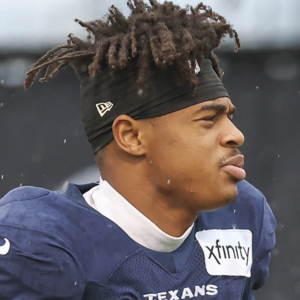It’s that time of year again when the sun is shining, the trees are green, and the only Edmonton Oilers hockey we get to watch is from the archives.
It’s also reached the point of the year when I review all of the Oilers players’ seasons, digging into their numbers, their impacts and the like.
Today, I’m going to dive into all the tools and methodologies I use in these upcoming articles, as well as in my hockey analysis as a whole. I’m one who firmly believes in utilizing both eyes and analytics in evaluating the game.
The analytics

All the analytics references here today, and utilized moving forward, come from Natural Stat Trick, one of the few publically available analytics websites. The numbers above, all at five-on-five are those of Evan Bouchard’s, so using those, let’s talk about what we’re seeing here.
His numbers are broken up into two sections: the top being his individual numbers, and the bottom being his on-ice impacts. Things are colour-coordinated with blue representing good numbers, and orange representing bad numbers. The colour light gray is used as the mid-point for all these numbers, and each is represented in comparison to an average of every Oilers forward and defenceman from last season not named Phil Kemp, who played all of one game for the team last season. Simply put, the deeper the blue, the higher above average that number is, while the deeper the red, the lower below average they are.
As you look at the jumble of numbers, I decided to leave raw shot attempt, scoring chance, goal and expected goal numbers without any colour coordination. That’s because it could skew context, given time on ice, which is better represented by the per 60 statistics.
It’s always important to remember context when diving into analytics, and even when looking at, so let’s look at his numbers, from left to write, and highlight what they are.
The Numbers
Per/60
Right off the top, this looks at the statistic divided by 60, representing a full three-period game. This allows us to help create balance in sample sizes.
RelTM%
This is the difference between the team’s stat with the player on the ice, compared to the team’s stat with the player off the ice. It doesn’t include games where the player is not playing. This allows us to provide even more balance in sample sizes.
TOI+TOI/GP
This one is simple: his total time on ice, and their average time on ice per game played.
G A P
Goals, assists, points.
IPP
Individual point percentage. This number represents the percentage of goals that the player contributed to, by either scoring or assisting, while on the ice. It’s calculated by dividing total points by goals for.
SOG
Shots on goal.
SH%
Shooting percentage.
ixG
Individual expected goals. This looks at how many goals a player is expected to have scored, based on Natural Stat Trick’s model.
Simply put: this is a metric that looks at shot quality.
iSCF
Individual scoring chance.
iHDCF
Individual high-danger scoring chance.
Blocks
Blocked Shots.
FO%
Faceoff percentage.
CF, CA, CF%
Shot attempt for, shot attempt against, shot attempt share.
This counts any shot attempt, including ones that result in goals, shots on net, misses, and blocks.
SCF, SCA, SCF%
Scoring chance for, scoring chance against, scoring chance share.
A scoring chance, as defined by War-On-Ice.
GF, GA, GF%
Goals for, goals against, goal share.
xGF, xGA, xGF%
Expected goals for, expected goals against, expected goal share.
PDO
Shooting percentage + save percentage.
1.0 represents even, while below can be considered unlucky, and over can be considered lucky.
The Charts

Now we get to the fun stuff.
Once again, I’ll be using Micah Blake McCurdy’s excellent charts to help dive into players, which are hosted on hockeyviz.com. We’ll look at their isolated impact charts, and their smoothed goal history. These are excellent tools, as they account for teammates, competition and coaching, to give an isolated look at an individual player and highlight where the player creates shots from.
Starting with the isolated impact charts, the colour red represents a high volume of shots, while blue represents a low volume of shots. In the upper left, that looks at where a player causes shots to be taken from in the offensive zone. The deeper the red colour, the more the player does to have shots taken from that area, which is good. The blue represents where the least amount of shots are taken from. There’s a value given at the bottom, which indicates how much further above (+) or below (-) league average the player is at generating expected goals per hour.
On the bottom left, this is the defensive zone, so where there’s a lot of blue, there’s a lot of good happening because few shots are being taken from this area. Similarly, there’s a value at the top of this image that indicates how much further above (-) or below (+) league average this player is at limiting expected goals against per hour. It’s worth noting the negative values are the positive, as they indicate fewer expected goals against per hour.
Top right and bottom right are power play and penalty kill, respectively, where red is replaced by orange, and blue is replaced by purple.
In the middle of the chart, there’s a sG value, which is an “all-in-one” statistic to evaluate a player’s current value, with 0 representing a slightly below-average third-line forward, or an average second-pairing defenceman. This is an important distinction, as other models, such as Wins Above Replacement (WAR) or Goals Above Replacement (GAR), are also descriptive of a player’s past. sG values are also placed on a player’s finishing (scoring), setting (passing), 5v5 offence and defence, power play, penalty kill, as well as drawing and taking penalties. Evan Bouchard’s +6.2 sG shows him contributing at a rate beyond that of a first-pairing defenceman, as seen in the sG History chart, which also highlights his value over time.
If you want to read more about Micah Blake McCurdy’s methodology, you can read about the isolated impact charts here and the smoothed goal model here.





